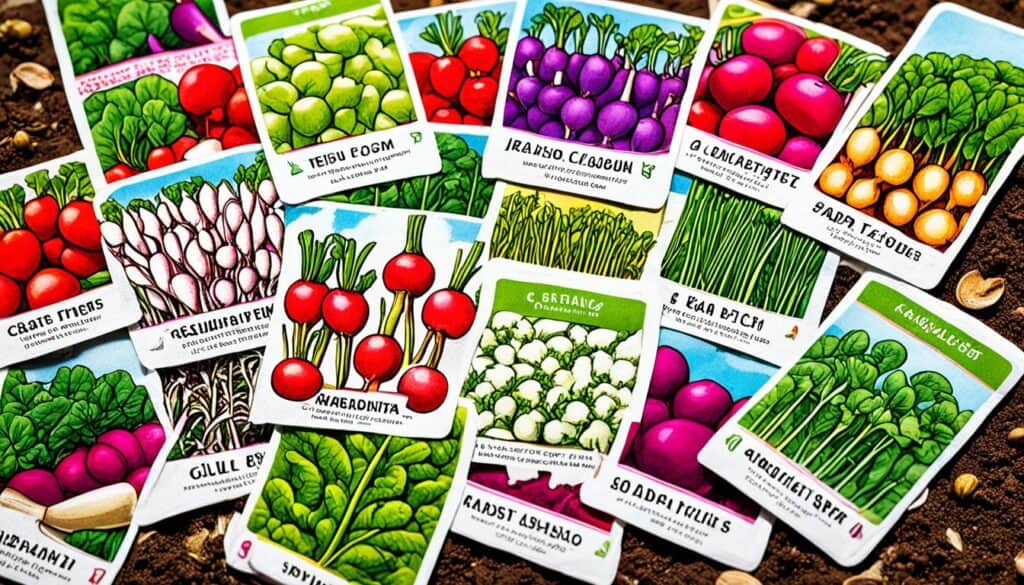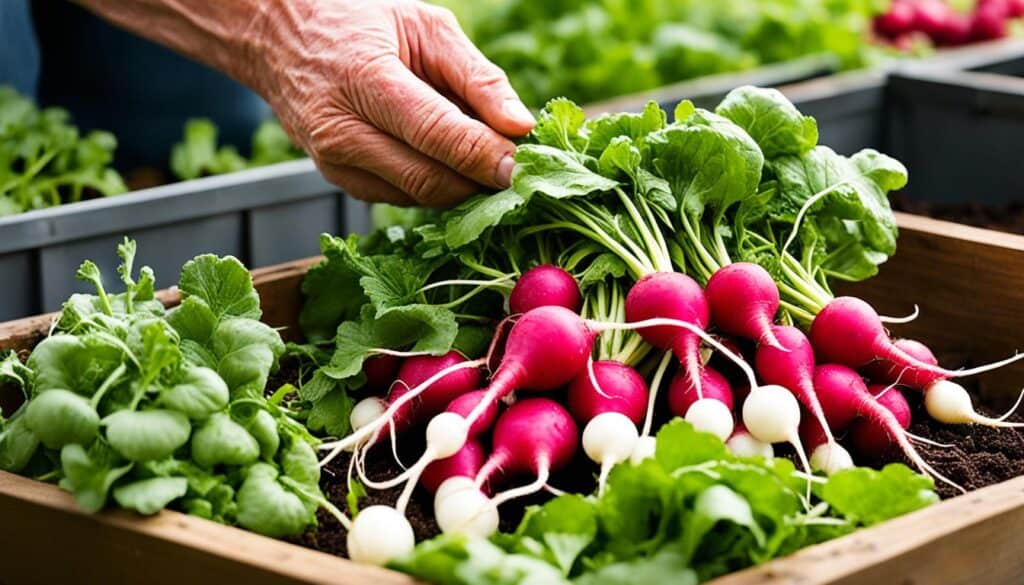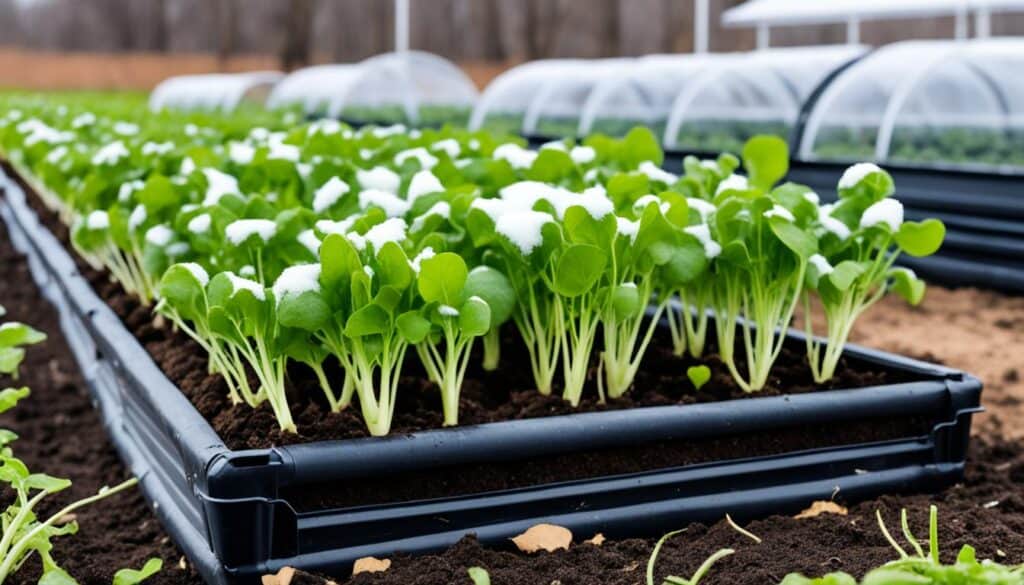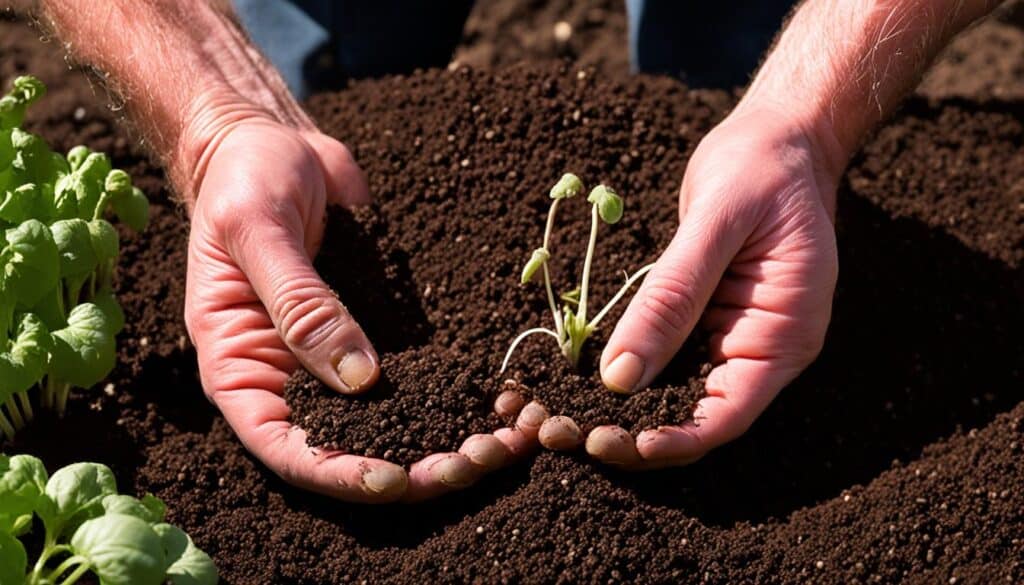Did you know that radish seeds are not only easy to grow but also offer a bountiful harvest in just a matter of weeks? Whether you’re a seasoned gardener or a beginner, cultivating radish seeds in your own garden is a gratifying experience that can yield delicious and nutritious results. With their vibrant hues and crisp textures, radishes are not only a popular addition to salads and stir-fries but also a great source of fiber, vitamins, and minerals.
If you’re ready to get your hands dirty and embark on an exciting radish-growing journey, this article is for you. I will provide valuable tips and insights on how to successfully grow radish seeds, from choosing the right varieties to harvesting and storing your bountiful crop. Get ready to enjoy the satisfaction of plucking fresh radishes straight from your own garden!
Key Takeaways:
- Radish seeds are easy to grow and offer a quick harvest, making them perfect for gardeners of all skill levels.
- Cultivating radish seeds provides access to fresh, flavorful, and nutritious vegetables for use in a variety of dishes.
- By following the tips in this article, you can create a thriving radish garden and enjoy a continuous supply of vibrant and crunchy radishes.
- Consider choosing organic radish seeds for a more sustainable and eco-friendly gardening experience.
- Remember to prepare your soil properly, provide adequate watering and care, and harvest your radishes at the right time for the best flavor and texture.
Choosing the Right Radish Seed Varieties
When it comes to selecting radish seeds, there are a wide range of options available. Whether you’re a seasoned gardener or just starting out, choosing the right seed varieties is crucial for a successful harvest. Here are some key factors to consider:
Heirloom Radish Seeds: Preserving Traditions
For those passionate about preserving traditional plant varieties, heirloom radish seeds are an excellent choice. These seeds have been passed down through generations, maintaining their unique traits and flavors. By planting heirloom radish seeds, you can contribute to the preservation of these diverse and historic plants.
High-Quality and Non-GMO Radish Seeds
When it comes to radish seeds, quality matters. Opting for high-quality seeds ensures better germination rates and healthier plants. Look for reputable seed suppliers that provide detailed information about their sourcing and production processes. Choosing non-GMO radish seeds further ensures that you’re supporting sustainable and environmentally friendly practices.
Exploring Radish Seed Varieties
With so many radish seed varieties available, it’s helpful to do some research and find the ones that best suit your preferences and gardening goals. Consider factors such as taste, size, color, and maturity time. Some popular radish varieties include:
| RADISH VARIETY | DESCRIPTION |
|---|---|
| Cherry Belle | A classic round red radish with a crisp texture and mild flavor. |
| French Breakfast | An oblong radish with a red top and white bottom, known for its slightly spicy taste. |
| Watermelon | A striking variety with a green exterior and a pink interior, offering a sweet and refreshing flavor. |
| Black Spanish | A larger radish with a black skin and a spicy taste, often used in recipes and pickling. |
Remember to refer to the seed packets or consult with local garden experts for specific growing instructions and tips for each radish variety. By carefully selecting the right radish seed varieties, you can ensure a bountiful and delicious harvest.
Planting Conditions and Timing
Radishes are a relatively easy crop to grow and can thrive in various conditions. While they prefer full sun, they can also tolerate partial shade, making them versatile for different garden setups. To ensure a continuous harvest, many gardeners choose to plant radish seeds in bulk to maximize their yield.
When it comes to obtaining radish seeds, it’s crucial to select a reputable supplier to ensure the quality and viability of the seeds. As a top radish seed supplier, we understand the importance of providing high-quality seeds that will result in a successful harvest. Our bulk radish seeds are carefully selected, ensuring that you receive the very best for your garden.
The timing of planting radish seeds is influenced by the specific variety and the local climate. Recommended guidelines and frost dates should be followed to determine the ideal planting time. By considering these factors, you can optimize the growth and yield of your radish plants.
Just like any other crop, radishes thrive when they are planted in the right conditions with proper timing. Let’s explore the key points to consider:
Radish seeds are often planted in bulk to ensure a continuous harvest.
It’s important to choose a reputable radish seed supplier to ensure the quality of the seeds.
The planting timing will depend on the specific variety and the local climate, so it’s essential to follow the recommended guidelines and consider frost dates.
H3: The Importance of Planting Conditions
The success of your radish garden heavily relies on the planting conditions and timing. By creating an optimal environment for your radish seeds, you can encourage healthy growth and maximize the yield. Radishes prefer full sun but can tolerate partial shade, so choose a location in your garden that receives ample sunlight throughout the day.
The soil quality is also crucial. Before planting, ensure that the soil is well-drained and rich in organic matter. Loose soil allows the radish roots to grow straight and develop properly. Prepare the soil by removing any rocks or debris and incorporating compost or well-rotted manure to enhance fertility.
Planting Timing
The timing of radish planting may vary depending on your location and the specific variety you choose. In general, radishes can be planted as soon as the soil can be worked in the spring. Follow the recommended planting dates for your area to avoid potential frost damage.
If you’re planning multiple harvests throughout the growing season, stagger your planting by sowing seeds every few weeks. This approach ensures a continuous supply of fresh radishes and allows you to make the most of your garden space.
Keep in mind that radishes can bolt and become bitter in hot weather, so consider planting them in early spring or late summer when temperatures are cooler.
Recommended Planting Times for Radish Varieties
| Variety | Recommended Planting Time |
|---|---|
| Early Scarlet Globe | Early spring, 2-4 weeks before the last frost date |
| Cherry Belle | Early spring or late summer |
| French Breakfast | Early spring or late summer |
| Watermelon Radish | Early spring or late summer |
| Daikon | Early spring or late summer |
Planting radish seeds at the right time is crucial for a successful harvest. Refer to this table to determine the recommended planting timeframe for different radish varieties:
- Early Scarlet Globe: Plant 2-4 weeks before the last frost date in early spring for an early harvest.
- Cherry Belle: Plant in early spring or late summer for a crisp and mild-flavored radish.
- French Breakfast: Sow seeds in early spring or late summer to enjoy this elongated variety with a mild, slightly spicy taste.
- Watermelon Radish: Plant in early spring or late summer for a strikingly colorful radish with a sweet flavor.
- Daikon: Sow seeds in early spring or late summer for this long, white, and mildly peppery radish variety.
Remember to adjust the planting dates based on your local climate and frost dates. By carefully considering the planting conditions and following the recommended timings, you’ll be on your way to growing an abundant radish harvest.
Soil Preparation and Planting Techniques
To ensure proper root formation, radishes require loose soil. Before planting, it’s essential to prepare the soil adequately.
To create the ideal conditions for radish growth:
- Spade or Till the Soil: Dig the soil to a depth of 8 to 12 inches using a spade or a garden tiller. This process loosens the soil, allowing the roots to grow and expand easily.
- Improve Soil Fertility: Enhance the soil’s fertility by adding organic matter, such as composted manure. This increases nutrient levels, aiding in radish growth and development.
- Follow Planting Techniques: Different radish seed varieties may have specific planting techniques. Follow the instructions given on the seed packet or consult with a local gardening expert for tailored advice.
When planting radish seeds, here are some general guidelines to keep in mind:
- Planting Depth: Radish seeds are typically planted at a depth of 1/2 inch. This ensures that the seeds have adequate contact with the soil for germination.
- Spacing: Space the radish seeds about 1 inch apart to give the plants enough room to grow and develop. Proper spacing also prevents overcrowding and competition for resources.
Benefits of Proper Soil Preparation and Planting
By preparing the soil and following proper planting techniques, gardeners create optimal conditions for radish growth. Loose soil allows the roots to penetrate easily, promoting healthy root development. Improved soil fertility provides essential nutrients for the radish plants, ensuring robust growth and a bountiful harvest.
| Benefits of Proper Soil Preparation and Planting | Description |
|---|---|
| Promotes Healthy Root Development | Loose soil allows radish roots to penetrate easily, resulting in strong and well-developed roots. |
| Enhances Nutrient Availability | Organic matter improves soil fertility, providing essential nutrients for optimal radish growth and development. |
| Prevents Overcrowding | Proper spacing between radish seeds prevents overcrowding, ensuring each plant has enough space to thrive. |
Care and Maintenance of Radish Seeds
Proper care and maintenance are essential for the successful growth of radish seeds. To ensure optimal results, follow these important steps:
Maintaining Moisture Levels:
Radish seeds require consistent moisture throughout the growing season. To keep the soil moist:
- Regularly water the radish plants, aiming for about 1 inch of moisture per week.
- If possible, use an irrigation system to provide a steady supply of water to the plants.
Weeding and Mulching:
To control weeds and maintain optimal soil conditions:
- Regularly weed the area around the radish plants to prevent competition for nutrients.
- Apply a layer of organic mulch, such as straw or wood chips, around the plants to suppress weeds and retain moisture.
Fertilization:
Regular fertilization can contribute to the healthy growth of radish plants. However, it’s important to use the right fertilizers:
Avoid using fresh manure or nitrogen-rich fertilizers. These can lead to excessive leaf growth at the expense of root development. Instead, use a balanced fertilizer or one specifically formulated for root crops.
By following these care and maintenance practices, you can ensure that your radish plants grow vigorously and produce delicious, healthy radishes.
Harvesting and Storing Radishes
Radishes mature quickly, with most varieties ready for harvest in 3 to 5 weeks. Harvesting radishes at different sizes can result in varying levels of spiciness. It’s important to monitor the growth of the radishes and harvest them when they reach a usable size. To harvest, gently pull the radish root from the soil, taking care not to damage the plant or break the root.
“Harvesting radishes at the right time ensures optimal flavor and texture. Radishes harvested when they are too small can be overly spicy, while those left in the ground for too long may become tough and woody.”
Once harvested, radishes can be stored in the refrigerator for several weeks. Before storing, trim off any excess leaves and wash the radishes to remove dirt. Place them in a perforated plastic bag or airtight container to maintain freshness. Properly stored radishes can retain their crispness and flavor for an extended period.
By harvesting radishes at the right time and storing them properly, you can enjoy the bountiful harvest for weeks to come.
Extending the Radish Growing Season
With proper planning, it’s possible to extend the radish growing season into the winter months. Some radish varieties, such as daikon and winter radishes, thrive in cooler temperatures. These varieties are ideal for late summer or early fall planting to ensure an autumn or early winter harvest. By providing protection from cold temperatures, such as using hoop houses or bringing potted radish plants indoors, gardeners can continue enjoying fresh radishes even in colder climates.
Winter radishes are known for their ability to withstand colder temperatures, making them the perfect choice for extending the radish growing season. Daikon radishes, in particular, are cold-tolerant and can withstand temperatures below freezing. Planting these varieties in late summer or early fall allows the radishes to mature during the cooler months, providing a fresh harvest when other vegetables may be scarce.
“By planning for a winter harvest, you can enjoy the crisp and refreshing taste of radishes even when the snow is falling. Winter radishes are a great addition to soups, stir-fries, and salads, adding a burst of flavor and color to your winter meals.”
To protect radish plants from frost and cold temperatures, hoop houses can be used. Hoop houses are simple structures made from PVC pipes or metal hoops covered with a plastic sheet. These structures create a mini greenhouse effect, trapping heat and protecting the radish plants from freezing temperatures. Another option is to bring potted radish plants indoors, placing them near a sunny window or under grow lights to continue their growth throughout the winter.
Winter Radish Varieties
| Radish Variety | Description | Approximate Days to Maturity |
|---|---|---|
| Daikon | A long, white radish with a mild and crisp flavor | 45-70 days |
| Black Spanish | A round, black radish with a spicy flavor | 55-60 days |
| China Rose | A cylindrical, pink radish with a mild and sweet flavor | 50-60 days |
By choosing the right radish varieties and providing protection from cold temperatures, gardeners can successfully grow radishes throughout the winter months. With some extra care and attention, you can continue enjoying the fresh and crunchy goodness of radishes, even when the snow is on the ground.
Additional Tips and Considerations
Here are some additional tips and considerations for successfully growing radish seeds:
- Thin out the radish seedlings to provide space for optimal growth.
- Make sure to water radishes deeply to reach their large taproots.
- Maintain a consistent watering schedule to ensure adequate moisture levels.
- Consider companion planting radishes with other vegetables to maximize space utilization and minimize pests.
- Rotate radish planting locations each year to prevent the buildup of soil-borne diseases.
- Explore different radish recipes and ways to enjoy the harvest, such as adding them to salads or roasting them alongside other root vegetables.
Conclusion
Growing radish seeds can be a rewarding experience for both novice and experienced gardeners. By following the growing tips for radish seeds provided in this article, you can create a lush radish garden and enjoy a bountiful harvest.
First, it’s important to choose the right seed varieties for your garden. Consider factors such as taste preference, color, and size when selecting radish seeds. Whether you opt for organic radish seeds or non-GMO varieties, make sure to purchase high-quality seeds from a reputable supplier.
Next, proper soil preparation is key to growing successful radishes. Ensure that the soil is loose and well-draining by tilling or spading the area before planting. Adding organic matter, such as composted manure, can boost soil fertility. Follow specific planting techniques for different radish seed varieties, and maintain consistent care and maintenance throughout the growing season.
With a little patience and effort, you can enjoy the satisfaction of harvesting fresh and flavorful radishes from your own garden. So start planning your radish seed garden today, and get ready to savor the delicious rewards!










Leave a Reply